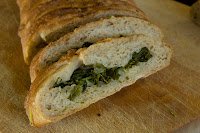 This week started the very short Black Locust (Robinia pseudoacacia) blossom season. The smell of perfume is heavy in the air around the trees, and we went out gathering the flower racemes. Robert likes to make a sweet drink from them by infusing them into honeyed water with lemons and dandelion flowers. We also picked a big bag full for a batch of peasant wine, and hope to try some fritters. There is a park here in Norwich that has quite a few very tall Black Locusts that are impossible to pick from, but we did hide a letterbox there, Foraging Black Locust. The only edible part of the tree is the blossom, all other parts are a bit toxic.
This week started the very short Black Locust (Robinia pseudoacacia) blossom season. The smell of perfume is heavy in the air around the trees, and we went out gathering the flower racemes. Robert likes to make a sweet drink from them by infusing them into honeyed water with lemons and dandelion flowers. We also picked a big bag full for a batch of peasant wine, and hope to try some fritters. There is a park here in Norwich that has quite a few very tall Black Locusts that are impossible to pick from, but we did hide a letterbox there, Foraging Black Locust. The only edible part of the tree is the blossom, all other parts are a bit toxic. We went out to gather more garlic mustard greens and green seed pods to boil and stuff into a bread to take to a potluck letterboxing gathering.
We went out to gather more garlic mustard greens and green seed pods to boil and stuff into a bread to take to a potluck letterboxing gathering. It was Wanda and Pete's retirement from letterboxing, and a great group of friendly letterboxers showed up to hike, eat, exchange and chat. We met Veganf, Misplaced Manatee and lionsmane, and chatted with Celtic Roots, Bluebird, Wanda and Pete, and others. Lenny from The Compass Cuties made some fresh Rhode Island Chowder to end the afternoon. Robert hiked with some folks, and Teabass was so brave to try some wild edibles they found!
It was Wanda and Pete's retirement from letterboxing, and a great group of friendly letterboxers showed up to hike, eat, exchange and chat. We met Veganf, Misplaced Manatee and lionsmane, and chatted with Celtic Roots, Bluebird, Wanda and Pete, and others. Lenny from The Compass Cuties made some fresh Rhode Island Chowder to end the afternoon. Robert hiked with some folks, and Teabass was so brave to try some wild edibles they found! At the Browning Mill Pond Recreational Area, we found the biggest patches of Indian cucumber (Medeola virginiana) we have seen. In some areas like Florida and Illinois the plant is endangered. We don't usually dig a lot of roots, since they are small and it kills the plant, but they make a nice trailside nibble. They like rather wet and shady areas with rich soil. The foliage is out now, and some plants are producing flowers. Robert brought some home to sautée, and they keep their sweet crunchiness with cooking. We planted Foraging Indian Cucumber last year at Gay City State Park in Hebron, Connecticut.
 Another new edible we tried this week is smilax, or greenbrier. There are more than 300 species of smilax, but they all have similar characteristics. They are a vining shrub and will grow into large thickets. They have thorns and tendrils, and the identification is based on the placement of the leaves and tendrils. The very top portion of the vine is snapped off, and either eaten raw or lightly boiled. We both agreed it is pretty tasty, and will experiment with it some more.
Another new edible we tried this week is smilax, or greenbrier. There are more than 300 species of smilax, but they all have similar characteristics. They are a vining shrub and will grow into large thickets. They have thorns and tendrils, and the identification is based on the placement of the leaves and tendrils. The very top portion of the vine is snapped off, and either eaten raw or lightly boiled. We both agreed it is pretty tasty, and will experiment with it some more.We noticed the withered, brown Japanese knotweed patches along the roadsides in rural Connecticut. They are spraying them with herbicides to try to eradicate this invasive plant, but I think all they are accomplishing is poisoning the environment. It takes numerous applications of poison to kill the plant since it reproduces through it's rhizomes as well as it's seeds. We do not recommend foraging near roadways and along railroad tracks due to herbicide and poison usage, and pollution from cars and salt.

No comments:
Post a Comment